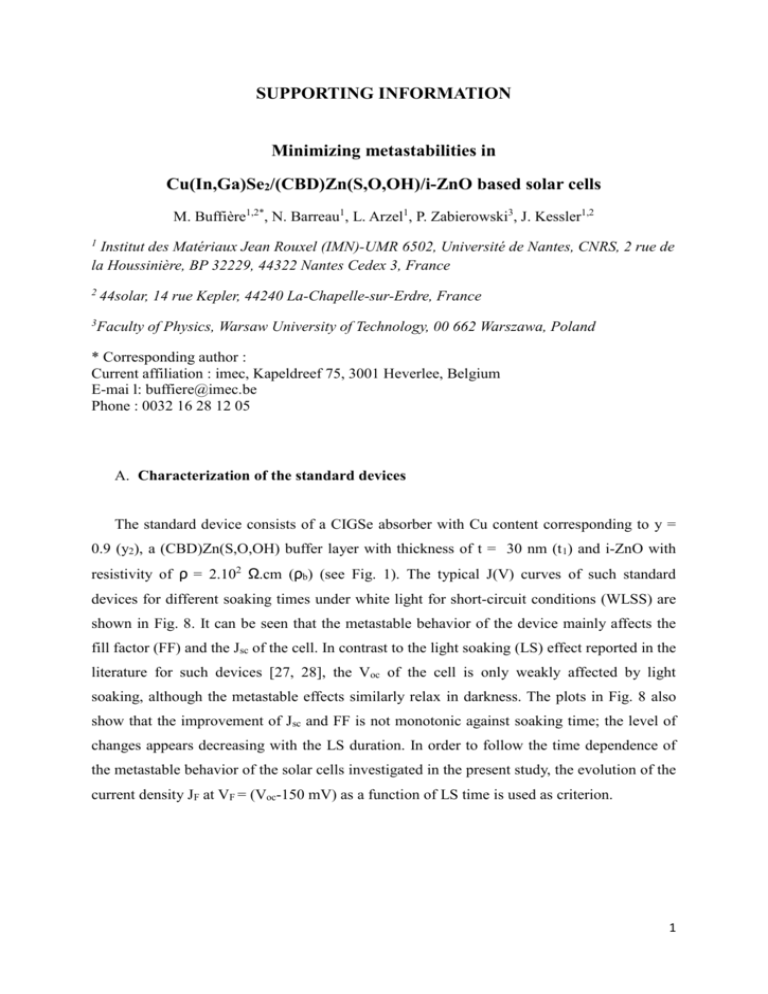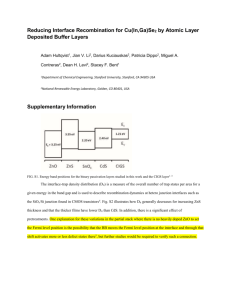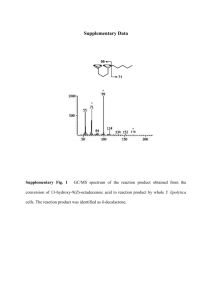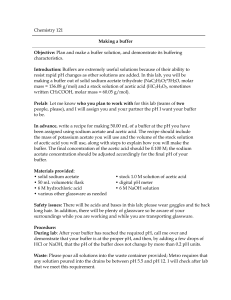pip2451-sup-0001-figuresandtables
advertisement

SUPPORTING INFORMATION Minimizing metastabilities in Cu(In,Ga)Se2/(CBD)Zn(S,O,OH)/i-ZnO based solar cells M. Buffière1,2*, N. Barreau1, L. Arzel1, P. Zabierowski3, J. Kessler1,2 1 Institut des Matériaux Jean Rouxel (IMN)-UMR 6502, Université de Nantes, CNRS, 2 rue de la Houssinière, BP 32229, 44322 Nantes Cedex 3, France 2 44solar, 14 rue Kepler, 44240 La-Chapelle-sur-Erdre, France 3 Faculty of Physics, Warsaw University of Technology, 00 662 Warszawa, Poland * Corresponding author : Current affiliation : imec, Kapeldreef 75, 3001 Heverlee, Belgium E-mai l: buffiere@imec.be Phone : 0032 16 28 12 05 A. Characterization of the standard devices The standard device consists of a CIGSe absorber with Cu content corresponding to y = 0.9 (y2), a (CBD)Zn(S,O,OH) buffer layer with thickness of t = 30 nm (t1) and i-ZnO with resistivity of ρ = 2.102 Ω.cm (ρb) (see Fig. 1). The typical J(V) curves of such standard devices for different soaking times under white light for short-circuit conditions (WLSS) are shown in Fig. 8. It can be seen that the metastable behavior of the device mainly affects the fill factor (FF) and the Jsc of the cell. In contrast to the light soaking (LS) effect reported in the literature for such devices [27, 28], the Voc of the cell is only weakly affected by light soaking, although the metastable effects similarly relax in darkness. The plots in Fig. 8 also show that the improvement of Jsc and FF is not monotonic against soaking time; the level of changes appears decreasing with the LS duration. In order to follow the time dependence of the metastable behavior of the solar cells investigated in the present study, the evolution of the current density JF at VF = (Voc-150 mV) as a function of LS time is used as criterion. 1 Fig. 8 Evolution of the electrical characteristics under AM1.5 at short circuit conditions for a standard CIGSe solar cell with 30 nm-thick Zn(S,O,OH) buffer layer. The evolution of the current density JF at VF=Voc-150 mV as a function of WLSS time will be further used to study the metastable behavior of different samples. For the reference sample, the effect of the nature of the light source on the metastable behavior is clearly demonstrated in Fig.9. The J(V) curves were recorded at 25 °C under red light (i.e. the photons are absorbed neither by the buffer nor by the window layers), white light (AM1.5G spectrum) or Xenon lamp (UV-rich). Whatever be the soaking time under red light, JF remains constant; which denotes that the FF does not change. Under white light, JF reaches its highest value after the device has been soaked for 20 min, meaning the FF improves through long term exposure. When the device is soaked with the Xenon lamp, J F reaches its highest level after only 1 min. Such spectrum-dependent metastable behavior emphasizes the benefits of the UV radiation for the cell to quickly reach its optimal level of energy conversion. This observation confirms that the barrier at the origin of the FF loss is located where the high energy photons are absorbed, that being the CIGSe/buffer/window region. This phenomenon seems rather similar to the red/blue effect observed for CdSbuffered devices [39]. 2 JF (mA/cm²) @ Voc-150 mV 25 20 Xe light AM1.5 Red light 15 10 5 0 1 2 3 4 5 6 7 8 9 10 Light Soaking time (min) Fig. 9 Evolution of JF as a function of the LS time for a 30 nm-thick Zn(S,O,OH)-buffered CIGSe solar cell under different illumination sources. The effect of the complete cells annealing at 200 °C in air for 10 min on their metastable behavior has also been investigated; this treatment is often used to improve the performance of Zn(S,O,OH)-buffered cells [21, 22]. Figure 10a shows the evolution of JF versus the WLSS time measured on a cell before and after annealing; it is observed that the time required to reach the highest JF value is reduced after annealing. In order to better locate the origin of this change, we have compared the impact of air annealing performed at different steps of the device fabrication, namely either after (CBD)Zn(S,O,OH) deposition (1) or after the device is completed (2). In contrast to the beneficial effect of treating the complete cell, the annealing after the buffer growth yields devices showing similar JF (mA/cm²) @ Voc-150 mV metastable behavior to untreated ones. 25 20 15 10 Before annealing o Annealed (200 C, air, 10 min) 5 0 1 10 Light Soaking time (min) (a) 3 1.0 EQE 0.8 0.6 0.4 Annealing (1) Annealing (1) + Light bias Annealing (2) 0.2 0.0 400 600 800 (nm) 1000 (b) Fig. 10 a. Semi-logarithmic plot of the evolution of JF as a function of the LS time for the reference sample under AM1.5G before and after thermal annealing of the cell (10 min at 200 °C in air). b. EQE spectra of the reference cell which underwent the annealing treatment either after the buffer layer deposition (1) or once the cell was completed (2). Figure 10b plots the external quantum efficiency (EQE) of devices annealed either before (annealing “1”) or after (annealing “2”) the window deposition (i.e. CIGSe/buffer or completed cell respectively); one should note that the measurements were performed at room temperature after the cell had been stored in darkness for several hours. Considering the device annealed before the window deposition, the EQE suggests that the Jsc loss is due to low collection length, which can be attributed to either a very low diffusion length (material related) or a very narrow space charge region (junction related). Nevertheless, EQE measurements under light bias (i.e. with an additional white light source at 0.3 sun intensity) lead to high improvement in the long wavelengths range, which supports the hypothesis of poor collection induced by a narrow space charge region. One should note that the long wavelengths gain is not persistent and quenches when the light bias source is switched off. Similar results have been observed for different CIGSe/buffer annealing durations. In contrast, as expected from the J(V) characteristics, the EQE of the device annealed after the TCO deposition shows optimal carrier collection throughout the whole wavelengths range even without light bias. The comparison of these two devices annealed either before or after the window deposition suggests that the annealing rather impacts the buffer/window interface and/or window properties than those of the buffer or CIGSe/buffer 4 interface. Furthermore, according to the EQE results, it seems that these annealing-induced changes in the buffer/window area imply changes of the near surface absorber region properties. All of the conclusions resulting from these investigations on the so-called standard solar cell structure suggest that the origins of the dominating optoelectronic metastabilities dwell within the absorber near surface/buffer/window region. Consequently, the properties of these stacked layers have been sequentially varied in order to determine the influence of each of them on the metastable behavior of the solar cell. B. Raman analysis corresponding the CIGSe absorbers with 3 different Cu concentrations The micro-Raman spectroscopy analyses performed on the CIGSe samples relative to the series (1) are shown in Fig. 11. The 514 nm laser used for these measurements allowed a surface sensitive analysis of the CIGSe layer (about 100 nm of penetration depth). For the sample containing the lowest amount of Cu (i.e. CIGSe (3)), the Raman spectrum exhibits an additional peak located at 158 cm-1, and a shoulder at 196 cm-1; these contributions can be assigned to Cu(In,Ga)3Se5 phase [40]. For the sample with the highest Cu content (CIGSe (1)) these peaks are not detected, whereas they have very low intensities for the CIGSe with intermediate Cu content (CIGSe (2)). This analysis reveals that decreasing the Cu content of the absorber leads to the formation of Cu(In,Ga)3Se5 phase, which is located at the surface of the absorber according to the EDS measurements. The presence of this phase at the interface with the buffer layer should be then taken into account in the interpretation of the results regarding the structure of the p-n junction of the devices. 5 Fig. 11 Micro-Raman spectra corresponding to the three CIGSe absorbers with different Cu contents. C. Electrical parameters corresponding to the part III.A and III.B TAB. I. Photovoltaic parameters of the solar cells with different absorber Cu contents after WLSS for both CdS and Zn(S,O,OH) buffer layers; is the duration needed by the cell to reach its highest level of performance. Sample Voc (mV) Jsc (mA/cm2) FF (%) Efficiency (%) (min) CIGSe(1)/CdS CIGSe(1)/Zn(S,O,OH) 620 550 31.2 31.7 74.4 69.7 14.4 12.2 4 CIGSe(2)/CdS CIGSe(2)/Zn(S,O,OH) 618 544 31.4 31.5 74.0 67.7 14.3 11.6 10 CIGSe(3)/CdS CIGSe(3)/Zn(S,O,OH) 610 541 31.2 31.4 72.7 65.1 13.8 11.1 60 6 TAB. II. Photovoltaic parameters of the solar cells with different Zn(S,O,OH) buffer layer thickness before WLSS (t0) and after WLSS (tmax). Sample Zn(S,O,OH) WLSS time 1 ( ~ 30 nm ) Zn(S,O,OH) 2 ( ~ 5 0 nm ) Zn(S,O,OH) 3 ( ~ 10 0 nm ) Voc (mV) Jsc (mA/cm²) FF (%) Effici ency (%) t0 550 15.1 22.0 1.82 tmax~ 20 min 565 31.1 67.7 11.9 t0 570 28.1 49.6 7.94 tmax~ 10 min 570 30.9 68.1 12.0 t0 575 30.7 58.3 10.3 tmax~ 2 min 575 30.8 68.1 12.1 The Cu-content of the CIGSe film strongly influences the metastable behavior of the devices based on Zn(S,O,OH) buffer layers; moreover it also influences the highest FF reached by the cells after WLSS. The limited gain in Jsc for these devices is mainly due to the change in positions and amplitudes of the optical losses (interferences) on the EQE spectra, since no anti-reflective coating has been used for these cells. When the CdS-based devices are considered, the efficiency is rather similar for the different CIGSe absorbers. The thickness of the Zn(S,O,OH) buffer layer also influences the metastable behavior of the devices; however, after LS, the efficiency of the different devices is very similar. 7








